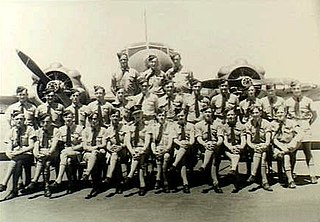No. 4 Service Flying Training School RAAF
| No. 4 Service Flying Training School RAAF | |
|---|---|

Advanced Training Squad of No. 4 Service Flying Training School in front of an Avro Anson, December 1942
|
|
| Active | 1941–45 |
| Allegiance | Australia |
| Branch | Royal Australian Air Force |
| Role | Intermediate/advanced flying training |
| Part of | Western Area Command |
| Garrison/HQ | Geraldton, Western Australia |
| Service | World War II |
| Commanders | |
| Notable commanders |
Norman Brearley (1942–44) |
| Aircraft flown | |
| Trainer | Avro Anson |
No. 4 Service Flying Training School (No. 4 SFTS) was a flying training school of the Royal Australian Air Force (RAAF) during World War II. It was formed in February 1941, and commenced flying the following month. Responsible for intermediate and advanced instruction of pilots under the Empire Air Training Scheme (EATS), the school was based at Geraldton, Western Australia, and operated Avro Anson aircraft. Two reserve squadrons were formed in response to the outbreak of war in the Pacific, though they never saw action. Flying activity was reduced towards the end of 1943, and the school was disbanded in May 1945, having graduated over 1,000 pilots. It re-formed as No. 87 Operational Base Unit, which was renamed Care and Maintenance Unit (CMU) Geraldton in May 1946. CMU Geraldton was disbanded in September 1947.
Flying instruction in the RAAF underwent major changes following the outbreak of World War II, in response to a dramatic increase in the number of aircrew volunteers and the commencement of Australia's participation in the Empire Air Training Scheme (EATS). The Air Force's pre-war pilot training facility, No. 1 Flying Training School at RAAF Station Point Cook, Victoria, was supplanted in 1940–41 by twelve elementary flying training schools (EFTS) and eight service flying training schools (SFTS). The EFTS provided basic flying training to prospective pilots who, if successful, would go on to SFTS for further instruction that focussed on operational (or "service") flying. The course at SFTS typically consisted of two streams, intermediate and advanced, and included such techniques as instrument flying, night flying, advanced aerobatics, formation flying, dive bombing, and aerial gunnery. The total duration of training varied during the war as demand for aircrew rose and fell. Initially running for sixteen weeks, the course was cut to ten weeks (which included seventy-five hours flying time) in October 1940. A year later it was raised to twelve weeks (including 100 hours flying time), and again to sixteen weeks two months later. It continued to increase after this, peaking at twenty-eight weeks in June 1944.
...
Wikipedia
